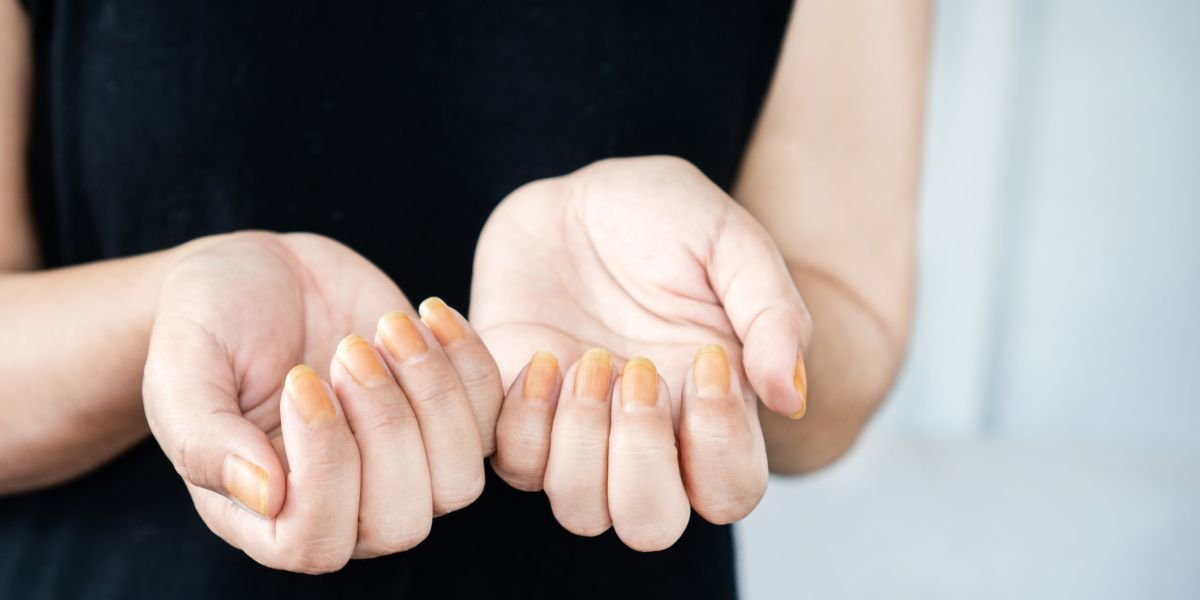How Can I Prevent and Treat Nail Fungus at Home?

To keep nail fungus at bay, simple habits like thorough drying and breathable footwear are key. But what if you’re already dealing with it? There are natural remedies and over-the-counter treatments to explore. Stay tuned to discover effective ways to tackle nail fungus right at home.
Causes of Nail Fungus
If your nails have become discolored, thickened, or brittle, you may be wondering what causes nail fungus. Nail fungus, also known as onychomycosis, is typically caused by dermatophytes, a type of fungi that thrives in warm, moist environments. These fungi can enter your nails through small cuts or separations between the nail and the nail bed. Additionally, yeast and molds can also cause nail infections.
Certain factors can increase your risk of developing nail fungus. These include wearing tight-fitting shoes that trap moisture, walking barefoot in damp areas like locker rooms or swimming pools, and having a weakened immune system. Aging, poor circulation, and conditions like diabetes can also make you more susceptible to nail fungus. Moreover, if you have a history of athlete’s foot, which is a fungal infection that affects the skin, you may be more prone to developing nail fungus as well.
Understanding these causes and risk factors can help you take preventive measures to protect your nails from fungal infections.
Prevention Strategies
To protect your nails from fungal infections, consider incorporating effective prevention strategies into your daily routine. Start by keeping your nails clean and dry, as fungi thrive in warm, moist environments. Make sure to thoroughly dry your feet and hands after washing them, especially in between the toes and fingers where moisture can get trapped. Wear breathable socks and shoes to allow air circulation and prevent excessive sweating. Opt for moisture-wicking socks and shoes made from breathable materials like cotton or leather.
Trim your nails regularly and avoid sharing nail clippers or other tools to reduce the risk of spreading fungal infections. If you frequent public swimming pools, showers, or gyms, wear protective footwear to minimize direct contact with contaminated surfaces. Be cautious when getting manicures or pedicures at nail salons, ensuring that the tools used are properly sanitized.
Additionally, maintain a healthy lifestyle with a balanced diet rich in vitamins and minerals to support strong nails and overall immune function. By following these simple prevention strategies, you can significantly reduce your risk of developing nail fungus.
Home Remedies
Consider incorporating natural remedies like tea tree oil or vinegar into your nail care routine to help combat nail fungus effectively. Tea tree oil is known for its antifungal properties and can be applied directly to the affected nail. Simply mix a few drops of tea tree oil with a carrier oil like coconut oil and apply it to the nail daily.
Vinegar, specifically apple cider vinegar, can also help fight nail fungus. Create a foot soak by mixing equal parts of apple cider vinegar and warm water, then soak your feet for 15-20 minutes a few times a week.
Another home remedy to try is garlic, which has natural antifungal properties. Crush a clove of garlic and mix it with olive oil to create a paste, then apply it to the affected nail. Let it sit for about 30 minutes before rinsing off.
Additionally, hydrogen peroxide can be used to kill fungus on the nails. Mix equal parts hydrogen peroxide and water, then soak your nails in the solution for a few minutes each day. These natural remedies can be effective in treating nail fungus at home.
Tips for Nail Fungus Treatment
For effective treatment of nail fungus, prioritize keeping your nails clean and dry to prevent further fungal growth. Wash your feet regularly with soap and water, ensuring to dry them thoroughly, especially between the toes where moisture can get trapped. Trim your nails straight across and file down thickened areas to reduce the chances of fungus spreading. Wear moisture-wicking socks and breathable shoes to keep your feet dry and prevent fungal growth. Additionally, alternate between different pairs of shoes to allow them to dry out completely between uses.
Consider using over-the-counter antifungal treatments like medicated nail polish or cream to target the fungus directly. Apply these treatments as directed, consistently and patiently, as it may take several weeks to see results. If home remedies don’t show improvement, consult a healthcare professional for further evaluation and prescription-strength options. Remember to maintain good foot hygiene practices even after the fungus has cleared to prevent future infections.

